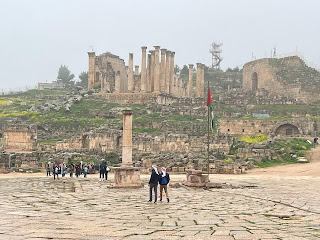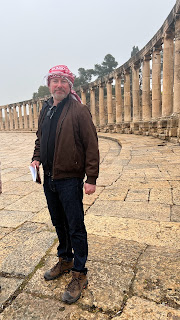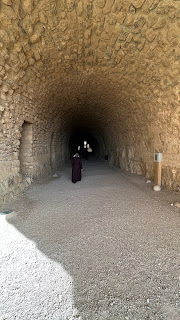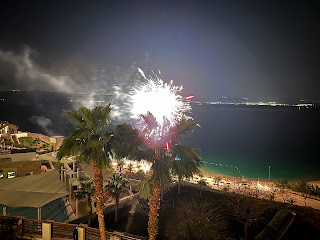Friday morning was our last full day in Jordan. With the current COVID-19 restrictions that remained in the US, this required us to get a negative COVID test the day before our flight. Fortunately, the Dead Sea Hilton had a contract with a doctor that would come and administer the test onsite and return the results the same day. We had an appointment mid-morning, which gave us a little bit of time to take the morning easy, and check out the dead sea.
The hectic pace of the trip and cold was catching up with Aimee and she decided to rest a bit in the room while I ran down to grab breakfast at the buffet. I did a "fly around" of the extensive buffet before grabbing a few basic items, and sat back down. With the frequent travel I do for work, I am a Hilton Diamond status member. Most of the time, this simply gets me some extra bottles of water, a snack, perhaps free hot breakfast, depending on the hotel. This time, it gave me celebrity status. Once I sat down a continual flow of staff every couple minutes came past my table, thanking me for my loyalty, welcoming me to the hotel, and asking if there was anything they could get for me. This included the manager, perhaps a chef, and several other of the staff, to the point that I began to be a little bit self-conscious of the attention I was getting. As I was finishing up the last few items on my plate, one of the staff came over, again thanking me for my Hilton loyalty, and asked if I had tried knafeh yet in Jordan. I admitted I had not. She excitedly said "let me get you a slice". She ran off and only seconds later, returned with a slice of some sort of a pastry that had a sticky/gooey sweet top layer with some pistachio crumbles on it, with some sort of cheese middle layer that seemed to have a consistency somewhere between warm pizza cheese and taffy on top of a crust. It was very tasty though quite sweet and quite heavy, especially after having just finished a full breakfast.
After finishing off my knafeh, I tried to get up quickly before I was fed more. I grabbed a couple snacks to bring up to Aimee and headed back up to the room.
We still had a bit of time before the doctor would be there, and had planned to use this time to run down to the Dead Sea. The Dead Sea is the lowest point on the face of the earth. If you're not aware, it is the final resting spot of the Jordan River and after thousands of years of the Jordan River entering into it and evaporating, it has extremely high salinity (and the lands and plains around it are resultingly rich in salt and potash, the farming of which is a very visible key industry around the Dead Sea). Interestingly, due to irrigation and other diversion of the water that feeds into the Dead Sea over the last few decades, it is evaporating faster now than it is filling. This is clear all along the cost line, as its beaches have the look of a large puddle that has been slowly drying up since a rain storm several days ago, with fairly clear edges and rings around it where the sea used to be. Even being on the coast of the Dead Sea, in order to get to it from our room, we had to take a few flights of stairs down to the pool area, and then take an elevator quite a bit further down to get to the beach access.
 |
| View of Dead Sea from the Hilton |
The beach was fairly small, with a steep slope down to the waters edge with several chairs and umbrellas lined up along the way. At the back were a few tables where they had Dead Sea mineral messages. There was only one other hotel guest in the area, wading up to his mid-torso in the small roped off area of the water. We asked the attendant from the massage tables what we were meant to do, and he explained that we should soak in the waters for 15 minutes, then (at this point there was some mis-understanding on my part) return to be covered in the Dead Sea mud, we would keep this on our skin for about 15 minutes and then we would rinse off back in the Dead Sea.
I headed down to the water (Aimee chose to spectate instead of participate) and began soaking. As I walked in, the other hotel guest was still wading torso deep in the water, about 20 feet from the beach. The water was warmer than I had anticipated (though at this low elevation the temperatures maintained 70-80 degrees, unlike the rest of our stay in the country) I began to walk towards him, and as soon as the water got to my knees, it felt like there were two hands on the back of my calves gently pushing me up. This was certainly unlike anything I'd experienced in a lake or an ocean. I continued to walk out in the direction of the other individual, and as the water rose past my belly button, my footsteps began to be much lighter and suddenly I was not touching the bottom, even though the surface was only between my belly button and chest. I now realized the other individual that I thought was wading was actually floating! (as I now was).
It became more and more apparent how unique this experience was from any "swimming" I'd ever done elsewhere. The water had a slightly more "slippery" feel than ocean or lake water. As I tried to maintain my balance using my feet and arms as I normally would, I bent my knees so I could paddle slightly with my feet, and suddenly I flipped backwards into a sitting position with my knees poking out of the surface. I struggled to put my feet under me, but as I did, the strong buoyancy tried to make me lay flat instead of go back to a vertical position. It took quite a bit of effort to get my feet under me and my body back into a vertical position. Once I achieved it, I instinctively bent my knees again, and flipped back to a sitting position with my knees in front of me. Remembering now that I was supposed to soak all of my skin for 15 minutes, I began to realize that was actually difficult to do, since so much of my body was above the surface and refused to go down.
After approximately 15 minutes, I determined it was time for the mud. Unfortunately I didn't realize until later the attendants were actually prepared to do the next step for me. I dug around the floor of the Dead Sea in the shallower end. Most of it was pebbly sand, but I was able to find a few chunks of mud. I took this mud, walked out of the water and began to apply it all over my body. After a few minutes I was covered head to toe and I wandered around the beach for the recommended 15 minutes. (During this time one of the attendants told me I used the wrong mud and they had better mud--which I realized they were simply harvesting from a few dozen yards down the coast away from the beach, though it was essentially the same as what I had used.) The longer the mud sat on my skin, the more I began to feel tingles and burning, especially on the parts of my face that were still chapped and cracked from all the cold weather exposure earlier in the week. After the appropriate wait time, I went back to the Dead Sea and rinsed off. My skin did feel much softer and smoother after this ordeal, and I went up to the showers next to the attendants tables to rinse the rest of the saltiness off myself, somewhat disappointed that I had inadvertently skipped the massage portion of the experience.
Aimee and I headed back up to the room, got ourselves cleaned up and put together for the day, and awaited the doctor's arrival. Since we were showering and such, we put the "Do Not Disturb" sign on our door.
The doctor was supposed to arrive at 11:00, however by 11:15am we still hadn't heard from him, so we called the front desk. They let us know the doctor was there at 11:00, but since there was a "Do Not Disturb" sign, they didn't knock. Fortunately, within minutes he was back at our door. The doctor, and one of the front desk staff entered, swabbed what I believe was a lobe of my brain from the feel of it, and left, letting us know that our results would be available by about 8:00pm.
With this we were free to go enjoy the rest of our day.
We jumped in the car and began driving north from the Dead Sea to the ancient Roman ruins at Jerash. While it was sunny and warm in the upper 70s already at the coast of the Dead Sea, it didn't take long as we quickly climbed elevation and moved further north that the sky became overcast, the temperature outside dropped, and it began raining again. The area around Jerash was a much different landscape than most of the Jordan we had experienced so far. While it was still very hilly/mountainous, the ground was covered in green instead of the red sand or yellow rock that we had become accustomed to. As we entered the city limits, it was clear this would be a wet and dreary day. While it was not a downpour, there was a constant light drizzle.
We found our way to the area of the ancient ruins, located in the center of the modern city, and began to look for a spot for lunch. I had identified Umm Khalil Lebanese House, however as we pulled up to it, it looked a bit more upscale than what we were dressed for, and so we continued to wander and look for other options.
Around the corner was a large restaurant called "Artemis." We decided to give this one a try. As we pulled in, it was clear from both the size of the restaurant and the large coach tour busses, that this was a popular place for all the tour groups. We parked and entered. The restaurant was a buffet with a large dining room with many tables set up for very large groups. Aimee and I got sat at a small 6 seater along the edges. I noticed on the menu, they had "Petra" beer available (which I had struck out a couple times when we were actually in Petra as our hotel, and the restaurant within Petra were both out of it) so I ordered one, and excitedly entered it into my Untappd app.
After replenishing our energy, we jumped back in the car, and drove around the corner to the parking lot for the ruins.
Immediately we learned that Jerash was set up differently than Petra. This was both good and bad. There was a large mall of vendors that you had to walk through in order to get into the actual ruins. We hoped this meant that the site would be devoid of aggressive souvenir touts. (that was mostly, but not entirely, correct). The bad part was, that you had to walk through a gauntlet of vendors and stalls with much of the same type of trinkets that were aggressively marketed to us throughout Petra. The vendors were just as aggressive at trying to suck passersby into conversation and a "free look" at their wares. We were really not interested in any more shopping at this point and hurriedly ran through the expansive market.
Once we exited into the grounds of the ancient ruins we were met with the imposing Arch of Hadrian which marked the entrance to this side of the ancient city. While there is evidence of human settlements in the area dating back to 3200 BC, and further evidence of human life another 4,000 years before that, the major developments of the area began with Alexander the Great in the 4th century BC, followed by Roman rule as an annex to Syria in the first century BC during which time most of the current ruins were built.
 |
| Arch of Hadrian |
Walking through the arch, led us into the city, and along side the ancient Roman arena called the Hippodrome. This arena had a capacity of 15,000 and was host to chariot races and other sports. I took the opportunity to walk up to a seat in the arena, and tried to envision what it would have been like to spend a weekend here 2,000 years ago watching a chariot race. The experience of walking under the stands, through a doorway, up to the edge of the arena and turning around and walking up the stairs to find my seat, was strangely similar to doing so in a modern stadium, causing a surreal mix of thoughts to go through my head of the parallels of attending a football game in the modern era vs. grabbing a seat for a race two millennia ago.
 |
| Seated in the Hippodrome |
In the distance to our left we could see the ruins of the Temple of Zeus. We had decided we would make our way back to that on our way out of the ruins, however, in the cool misty afternoon, the impressive remains of the structure in the distance still maintained a mysterious dominating presence in the ancient city.
 |
| Temple of Zeus looming over Jerash |
We exited the forum entering Cardo Maximus, the central main colonnaded street of the ancient city. The warm yellow hue of the stones even 2000 years after its construction hinted at what must have appeared under a bright sun as a city paved in gold. Not much further, on the left was the Agora, a central meeting place centered around a fountain.
 |
| The Agora |
Beyond the Agora, the Cardo Maximus continued for quite some distance, past the central intersection of the old city, with ruins off to either side in various states of disrepair. Interestingly some of the massive stone blocks and columns were set organized off the side of the main street, apparently laid for eventual restoration to their original places.
 |
| Cardo Maximus |

 |
| The Nymphaeum |
Continuing a bit further down the main road, we came to another intersection. Straight ahead, the Cardo Maximus led out of the old city. We took a left and ended up at the Northern Theater. This building is still mostly intact (or has been restored). Before entering the complex, we walked around the outside, and found a few small doorways. I peaked inside and saw that they had long passageways about 5 feet high, and with quite a bit of rubble and garbage on the floor. My adventurous side got the best of me, and I grabbed my flash light and entered. Aimee stayed behind to watch and see if I came back out in one piece. From my reading, I believe these passages originally led to trap doors on the stage of the theater. I was able to make my way about 20 feet into the passage way until it turned and had quite a bit more rubble, at which point I decided to end my trek, and head back out.
 |
| Entering the Tunnel |
 |
| Aimee Patiently Waiting for my Return |
 |
| Northern Theater |
From here we turned back to head towards where we came in, but returned along the backside of the city. Along this pathway we could see the ruins of several old churches from the ancient city, the Temple of Artemis, and the many columns around the site of the Church of St. Theodore.
 |
| The Forum from a distance |
Beyond these we walked a bit further toward the Temple of Zeus. Before arriving at that imposing site however, we stopped at the Southern Theater. This theater was a bit larger than the Northern Theater, but similar in design. We heard some music coming from inside that sounded like Scottish bagpipes. We were surprised when we got in to see that they were being played by a line of Jordanian men. They were just finishing up as we we walked in, and as the broke, a line of Indian (I think) men on the floor of the theater began singing mariachi songs. The cross culture music from both groups left us entertained, if not a slight bit confused.
 |
| Southern Theater |
Our final stop was the temple of Zeus. The ruins of this large temple sat high upon a hill, and had served well as our constant point of reference as it could be seen from most parts of the massive ancient city. This temple at the highest point of the ancient city originally had 17 massive columns. While the remains themselves were impressive, climbing up to the temple and taking a moment to enjoy the view of the entire ancient city was equally impressive.
 |
| Temple of Zeus |
 |
| Inside the Temple of Zeus |
 |
| View from Temple of Zeus |
This essentially concluded our tour of Jerash. We took our last few glimpses and returned back to the path that led out of the city and back to our car, embarking on the ~90 minute drive back to our hotel. The later half of this drive took us through the heavily ridden highways of Amman, and I will admit I had a bit of pride in how well I'd adapted to the driving culture in the country, which in general had far more loose adherence to lane markings, shoulders etc., (thought not quite as loose as places such as India...though I thought it was a good first step towards someday attempting to drive in India!)
As we neared the hotel district, we saw a very large souvenir store. We decided to stop in here and see if they had any nicer items than what we saw from all the touts and souvenir stands near the attractions. It was near closing time, and it was fairly empty inside, but with thousands upon thousands of items. Most of which were the same t-shirts, books, and trinkets we saw throughout the coutnry, but with a few displays of higher end items such as carved/inlaid furniture, dishes, mosaics, etc. At one point I noticed one of the workers was talking to some other tourists in french. I asked how many languages he spoke, and he said he could speak Russian, Spanish, Indonesian, Portuguese, and French (and of course Arabic). Given the current events of the prior week in Ukraine, he then caught himself and said "I don't speak Russian anymore." We spent a good bit of time in the large store, and talking to the store owners. The one individual I was talking to said his dream was to come to and work in America. He said that in America you can do anything you want to do, if you work for it. At one point he offered me some tea. I felt bad, as it somewhat goes against social norms, but I declined, as we did need to get back, grab dinner, and pack up.
After buying a few trinkets at the store, we returned to our hotel, cleaned ourselves up, and headed to the Italian restaurant on the grounds for our final dinner in Jordan. Given the regionally warm weather near the banks of the Dead Sea, we were able to enjoy our dinner, and a bottle of the local Jordan River Reserve wine, al fresco. Only a few other tables were filled with diners this evening, making for very peaceful surroundings. We were not looking forward to the long flight back and returning to reality---especially having already experienced the very cramped Royal Jordanian Airlines accommodations. Nonetheless, we forced ourselves back to our room, packed our suitcases, and headed to sleep for a few hours before driving to the airport, and returning home to the US.
One more adventured completed.
.














































